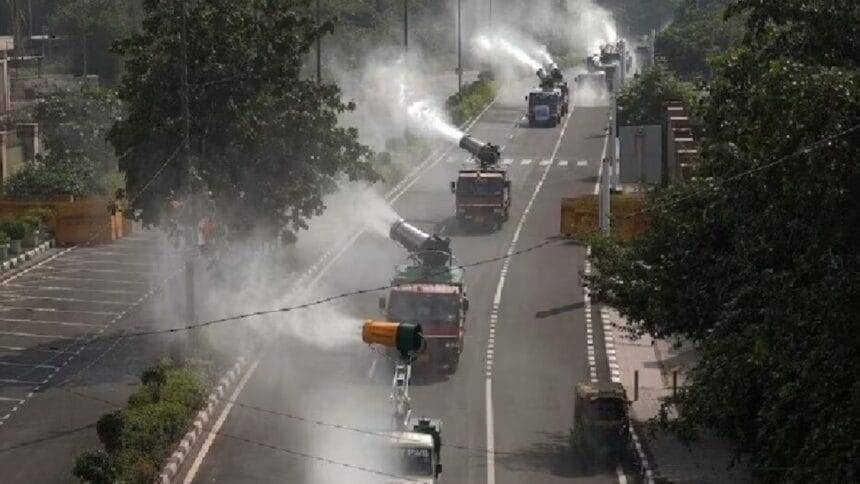Main Points In Hindi (मुख्य बातें – हिंदी में)
यहां दिल्ली की वायु प्रदूषण की स्थिति के मुख्य बिंदु दिए गए हैं:
-
वायु गुणवत्ता में गिरावट: दिल्ली का वायु गुणवत्ता सूचकांक (AQI) लगातार गिर रहा है, और अक्टूबर महीने में दिल्ली भारत का सबसे प्रदूषित शहर बन गया है। केंद्रीय प्रदूषण नियंत्रण बोर्ड के अनुसार, सुबह 9 बजे AQI 356 तक गिर गया है।
-
स्थानीय कारकों का प्रभाव: IIT दिल्ली के शोध में बताया गया है कि दिल्ली में सर्दियों के दौरान प्रदूषण के लिए स्थानीय कारण जिम्मेदार हैं। दूरदराज के स्रोतों से प्रदूषण की भूमिका जून और अक्टूबर में अधिक होती है।
-
नैशनल कैपिटल रीजन का प्रदूषण: Center for Research on Energy and Clean Air (CREA) की एक विश्लेषण में पाया गया कि अक्टूबर में भारत के टॉप 10 सबसे प्रदूषित शहरों में सभी NCR के शहर शामिल हैं, जिनमें गाज़ियाबाद, नोएडा और गुरुग्राम शामिल हैं।
-
स्थानीय परिवहन का योगदान: IIT दिल्ली के अध्ययन के अनुसार, जून महीने में दीर्घ दूरी के परिवहन का प्रदूषण में योगदान 65-75 प्रतिशत था, जो मानसून के बाद बढ़कर 85 प्रतिशत पहुंच गया।
- बेकाबू स्थिति: हाल के दिनों में, दिल्ली के चार स्टेशनों पर वायु गुणवत्ता "गंभीर" श्रेणी में रही है, और लोगों को बेहद प्रदूषित हवा का सामना करना पड़ रहा है।
Main Points In English(मुख्य बातें – अंग्रेज़ी में)
Here are the main points regarding the deteriorating air quality in Delhi:


-
Severe Air Pollution Levels: Delhi has witnessed alarming levels of air pollution, with the Central Pollution Control Board reporting an air quality index (AQI) of 356, categorizing it as "severe" at four monitoring stations (Bawana, Mundka, Wazirpur, NSIT Dwarka).
-
Top Polluted Cities in NCR: Analysis by the Center for Research on Energy and Clean Air (CREA) indicates that all of the top 10 most polluted cities in India for October are located in the National Capital Region (NCR), with Ghaziabad recording the highest levels of PM2.5 pollution.
-
Impact of Local and External Factors: Research from IIT Delhi highlights that local factors contribute significantly to pollution in winter, while in October, pollution is mainly driven by external sources. The share of stubble burning in PM2.5 pollution for Delhi in October was found to be less than 10%.
-
Increasing Pollution Trends: The average PM2.5 levels in Delhi for October were about 2.5 times higher than those in September, signaling a significant deterioration in air quality.
- Recent Air Quality Reports: On consecutive days, Delhi’s AQI remained high in the "very poor" category, peaking at 384 on Tuesday, indicating an ongoing public health concern for residents.
Complete News In Hindi(पूरी खबर – हिंदी में)
दिल्ली का वायु प्रदूषण हर दिन बढ़ता जा रहा है। एक अध्ययन में कहा गया है कि स्थानीय कारण मुख्य रूप से इस खराब वायु गुणवत्ता के लिए जिम्मेदार हैं। अक्टूबर के महीने में, दिल्ली भारत का सबसे प्रदूषित शहर बन गया है। केंद्रीय प्रदूषण नियंत्रण बोर्ड के अनुसार, सुबह 9 बजे एयर क्वालिटी इंडेक्स 356 पर पहुँच गया, जबकि चार जगह – बवाना, मुंडका, वजीरपुर और एनएसआईटी द्वारका – ने “गंभीर” श्रेणी में वायु गुणवत्ता की रिपोर्ट दी।
पुणे के ऊर्जा और स्वच्छ वायु केंद्र (CREA) द्वारा किए गए विश्लेषण में बताया गया है कि अक्टूबर में भारत के शीर्ष 10 सबसे प्रदूषित शहर राष्ट्रीय राजधानी क्षेत्र (NCR) में थे। इनमें गाज़ियाबाद (110 माइक्रोग्राम प्रति घन मीटर), मुजफ्फरनगर (103), हापुड़ (98), नोएडा (93), मेरठ (90), चरखी दादरी (86), ग्रेटर नोएडा (86), गुरुग्राम (83) और बहादुरगढ़ (83) शामिल हैं। वहीं, दिल्ली का अक्टूबर औसत सितंबर के औसत 43 माइक्रोग्राम प्रति घन मीटर से 2.5 गुना अधिक था। CREA के विश्लेषण के अनुसार, अक्टूबर में दिल्ली में पीएम2.5 प्रदूषण में पराली जलाने का योगदान 10 प्रतिशत से कम था।
आईआईटी के शोध में बड़ा खुलासा
आईआईटी दिल्ली के शोध ने बताया है कि सर्दियों में दिल्ली के प्रदूषण के लिए स्थानीय कारक जिम्मेदार हैं, जबकि जून और अक्टूबर में प्रदूषण बाहरी स्रोतों के कारण होता है। शोध में यह भी बताया गया है कि जब प्रदूषण बढ़ता है, तो नियमों का उल्लंघन होता है। यह शोध आईआईटी दिल्ली के वायुमंडलीय विज्ञान अध्ययन केंद्र द्वारा किया गया है और इसका शोध पत्र नीदरलैंड के एल्सेवियर जर्नल में प्रकाशित हुआ है।
दिल्ली के प्रदूषण मापने की प्रक्रिया
आईआईटी दिल्ली के अध्ययन ने दिल्ली के प्रदूषण मापने की प्रक्रिया को स्पष्ट किया है। जब स्थानीय परिवहन और लंबी दूरी के वाहनों द्वारा निर्मित प्रदूषण के तत्वों का अध्ययन किया गया, तो पाया गया कि जून महीने में लंबी दूरी के परिवहन का प्रदूषण में योगदान 65-75 प्रतिशत था, जो मजबूत मॉनसून के कारण बढ़कर 85 प्रतिशत तक पहुँच गया।
दिल्ली में वायु अधिक जहरीली हो गई
दिल्ली के निवासियों ने बुधवार की सुबह जहरीली हवा का सामना किया क्योंकि वायु गुणवत्ता “बहुत खराब” श्रेणी में रही। केंद्रीय प्रदूषण नियंत्रण बोर्ड (CPCB) के अनुसार, एयर क्वालिटी इंडेक्स सुबह 9 बजे थोड़ी गिरावट के साथ 356 पर पहुँच गया, जबकि बवाना, मुंडका, वजीरपुर और एनएसआईटी द्वारका ने “गंभीर” श्रेणी में वायु गुणवत्ता की रिपोर्ट दी। पिछले दो दिनों से दिल्ली का AQI उच्च “बहुत खराब” श्रेणी में रिकॉर्ड किया गया है। सोमवार को 9 बजे 373 और मंगलवार को 384 का रिकॉर्ड देखा गया।
यह भी पढ़ें –
Complete News In English(पूरी खबर – अंग्रेज़ी में)
Delhi’s air is getting worse with each passing day. In the study, local reasons have been said to be mainly responsible for the deteriorating air. It has been said that Delhi has been the most polluted city of India in the month of October. According to the Central Pollution Control Board, the air quality index dropped to 356 at 9 am, while four stations – Bawana, Mundka, Wazirpur and NSIT Dwarka – reported air quality in the “severe” category.
Analysis by the Center for Research on Energy and Clean Air (CREA) has revealed that all the top 10 polluted cities of India in October were in the National Capital Region (NCR). These cities include Ghaziabad (110 micrograms per cubic meter), Muzaffarnagar (103), Hapur (98), Noida (93), Meerut (90), Charkhi Dadri (86), Greater Noida (86), Gurugram (83) and Bahadurgarh. (83) Contains. At the same time, Delhi’s October average was 2.5 times more than the September average of 43 micrograms per cubic metre. According to CREA analysis, the share of stubble burning in PM2.5 pollution in Delhi in October was less than 10 percent.
Big revelation in IIT’s research
Research by IIT Delhi has revealed that local factors are responsible for the pollution in Delhi in winter, whereas the pollution in June and October is caused by outside sources. Research has also revealed that in case of increase in pollution, the rules of the grape are violated. The research has been done by the Center for Atmospheric Science Studies of IIT Delhi and its research paper has been published in the Elsevier Journal of the Netherlands.
Delhi’s pollution measurement process
The research of IIT Delhi has clarified the measurement process of Delhi’s pollution. When the polluting elements produced by local transport as well as long distance vehicles were studied, it was found that the average contribution of long distance transport to pollution in the month of June was 65-75 per cent, which was 65-75 per cent compared to pre- Due to strong monsoon storm it reached 85 percent.
Air becomes more poisonous in Delhi
Delhiites faced poisonous air on Wednesday morning as the air quality remained in the “very poor” category. According to the Central Pollution Control Board (CPCB), the air quality index fell marginally to 356 at 9 am, while four stations – Bawana, Mundka, Wazirpur and NSIT Dwarka reported air quality in the “severe” category. For the last two days, Delhi’s AQI has been recorded in the high “very poor” category. A reading of 373 was recorded at 9 am on Monday and 384 on Tuesday.
Read this also –






